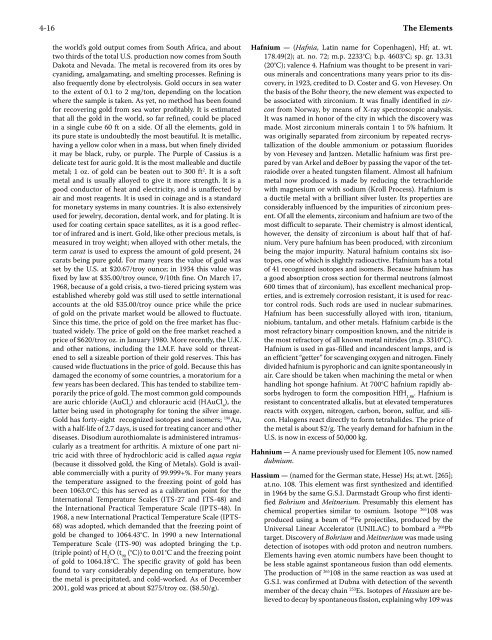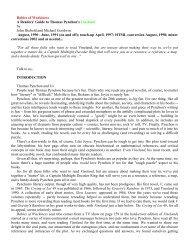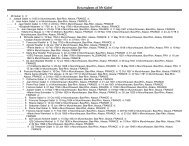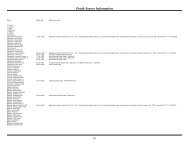CRC Handbook of Chemistry and Physics, 86th Edition
CRC Handbook of Chemistry and Physics, 86th Edition
CRC Handbook of Chemistry and Physics, 86th Edition
You also want an ePaper? Increase the reach of your titles
YUMPU automatically turns print PDFs into web optimized ePapers that Google loves.
4-16 The Elements<br />
the world’s gold output comes from South Africa, <strong>and</strong> about<br />
two thirds <strong>of</strong> the total U.S. production now comes from South<br />
Dakota <strong>and</strong> Nevada. The metal is recovered from its ores by<br />
cyaniding, amalgamating, <strong>and</strong> smelting processes. Refining is<br />
also frequently done by electrolysis. Gold occurs in sea water<br />
to the extent <strong>of</strong> 0.1 to 2 mg/ton, depending on the location<br />
where the sample is taken. As yet, no method has been found<br />
for recovering gold from sea water pr<strong>of</strong>itably. It is estimated<br />
that all the gold in the world, so far refined, could be placed<br />
in a single cube 60 ft on a side. Of all the elements, gold in<br />
its pure state is undoubtedly the most beautiful. It is metallic,<br />
having a yellow color when in a mass, but when finely divided<br />
it may be black, ruby, or purple. The Purple <strong>of</strong> Cassius is a<br />
delicate test for auric gold. It is the most malleable <strong>and</strong> ductile<br />
metal; 1 oz. <strong>of</strong> gold can be beaten out to 300 ft 2 . It is a s<strong>of</strong>t<br />
metal <strong>and</strong> is usually alloyed to give it more strength. It is a<br />
good conductor <strong>of</strong> heat <strong>and</strong> electricity, <strong>and</strong> is unaffected by<br />
air <strong>and</strong> most reagents. It is used in coinage <strong>and</strong> is a st<strong>and</strong>ard<br />
for monetary systems in many countries. It is also extensively<br />
used for jewelry, decoration, dental work, <strong>and</strong> for plating. It is<br />
used for coating certain space satellites, as it is a good reflector<br />
<strong>of</strong> infrared <strong>and</strong> is inert. Gold, like other precious metals, is<br />
measured in troy weight; when alloyed with other metals, the<br />
term carat is used to express the amount <strong>of</strong> gold present, 24<br />
carats being pure gold. For many years the value <strong>of</strong> gold was<br />
set by the U.S. at $20.67/troy ounce; in 1934 this value was<br />
fixed by law at $35.00/troy ounce, 9/10th fine. On March 17,<br />
1968, because <strong>of</strong> a gold crisis, a two-tiered pricing system was<br />
established whereby gold was still used to settle international<br />
accounts at the old $35.00/troy ounce price while the price<br />
<strong>of</strong> gold on the private market would be allowed to fluctuate.<br />
Since this time, the price <strong>of</strong> gold on the free market has fluctuated<br />
widely. The price <strong>of</strong> gold on the free market reached a<br />
price <strong>of</strong> $620/troy oz. in January 1980. More recently, the U.K.<br />
<strong>and</strong> other nations, including the I.M.F. have sold or threatened<br />
to sell a sizeable portion <strong>of</strong> their gold reserves. This has<br />
caused wide fluctuations in the price <strong>of</strong> gold. Because this has<br />
damaged the economy <strong>of</strong> some countries, a moratorium for a<br />
few years has been declared. This has tended to stabilize temporarily<br />
the price <strong>of</strong> gold. The most common gold compounds<br />
are auric chloride (AuCl 3 ) <strong>and</strong> chlorauric acid (HAuCl 4 ), the<br />
latter being used in photography for toning the silver image.<br />
Gold has forty-eight recognized isotopes <strong>and</strong> isomers; 198 Au,<br />
with a half-life <strong>of</strong> 2.7 days, is used for treating cancer <strong>and</strong> other<br />
diseases. Disodium aurothiomalate is administered intramuscularly<br />
as a treatment for arthritis. A mixture <strong>of</strong> one part nitric<br />
acid with three <strong>of</strong> hydrochloric acid is called aqua regia<br />
(because it dissolved gold, the King <strong>of</strong> Metals). Gold is available<br />
commercially with a purity <strong>of</strong> 99.999+%. For many years<br />
the temperature assigned to the freezing point <strong>of</strong> gold has<br />
been 1063.0°C; this has served as a calibration point for the<br />
International Temperature Scales (ITS-27 <strong>and</strong> ITS-48) <strong>and</strong><br />
the International Practical Temperature Scale (IPTS-48). In<br />
1968, a new International Practical Temperature Scale (IPTS-<br />
68) was adopted, which dem<strong>and</strong>ed that the freezing point <strong>of</strong><br />
gold be changed to 1064.43°C. In 1990 a new International<br />
Temperature Scale (ITS-90) was adopted bringing the t.p.<br />
(triple point) <strong>of</strong> H 2 O (t 90 (°C)) to 0.01°C <strong>and</strong> the freezing point<br />
<strong>of</strong> gold to 1064.18°C. The specific gravity <strong>of</strong> gold has been<br />
found to vary considerably depending on temperature, how<br />
the metal is precipitated, <strong>and</strong> cold-worked. As <strong>of</strong> December<br />
2001, gold was priced at about $275/troy oz. ($8.50/g).<br />
Hafnium — (Hafnia, Latin name for Copenhagen), Hf; at. wt.<br />
178.49(2); at. no. 72; m.p. 2233°C; b.p. 4603°C; sp. gr. 13.31<br />
(20°C); valence 4. Hafnium was thought to be present in various<br />
minerals <strong>and</strong> concentrations many years prior to its discovery,<br />
in 1923, credited to D. Coster <strong>and</strong> G. von Hevesey. On<br />
the basis <strong>of</strong> the Bohr theory, the new element was expected to<br />
be associated with zirconium. It was finally identified in zircon<br />
from Norway, by means <strong>of</strong> X-ray spectroscopic analysis.<br />
It was named in honor <strong>of</strong> the city in which the discovery was<br />
made. Most zirconium minerals contain 1 to 5% hafnium. It<br />
was originally separated from zirconium by repeated recrystallization<br />
<strong>of</strong> the double ammonium or potassium fluorides<br />
by von Hevesey <strong>and</strong> Jantzen. Metallic hafnium was first prepared<br />
by van Arkel <strong>and</strong> deBoer by passing the vapor <strong>of</strong> the tetraiodide<br />
over a heated tungsten filament. Almost all hafnium<br />
metal now produced is made by reducing the tetrachloride<br />
with magnesium or with sodium (Kroll Process). Hafnium is<br />
a ductile metal with a brilliant silver luster. Its properties are<br />
considerably influenced by the impurities <strong>of</strong> zirconium present.<br />
Of all the elements, zirconium <strong>and</strong> hafnium are two <strong>of</strong> the<br />
most difficult to separate. Their chemistry is almost identical,<br />
however, the density <strong>of</strong> zirconium is about half that <strong>of</strong> hafnium.<br />
Very pure hafnium has been produced, with zirconium<br />
being the major impurity. Natural hafnium contains six isotopes,<br />
one <strong>of</strong> which is slightly radioactive. Hafnium has a total<br />
<strong>of</strong> 41 recognized isotopes <strong>and</strong> isomers. Because hafnium has<br />
a good absorption cross section for thermal neutrons (almost<br />
600 times that <strong>of</strong> zirconium), has excellent mechanical properties,<br />
<strong>and</strong> is extremely corrosion resistant, it is used for reactor<br />
control rods. Such rods are used in nuclear submarines.<br />
Hafnium has been successfully alloyed with iron, titanium,<br />
niobium, tantalum, <strong>and</strong> other metals. Hafnium carbide is the<br />
most refractory binary composition known, <strong>and</strong> the nitride is<br />
the most refractory <strong>of</strong> all known metal nitrides (m.p. 3310°C).<br />
Hafnium is used in gas-filled <strong>and</strong> inc<strong>and</strong>escent lamps, <strong>and</strong> is<br />
an efficient “getter” for scavenging oxygen <strong>and</strong> nitrogen. Finely<br />
divided hafnium is pyrophoric <strong>and</strong> can ignite spontaneously in<br />
air. Care should be taken when machining the metal or when<br />
h<strong>and</strong>ling hot sponge hafnium. At 700°C hafnium rapidly absorbs<br />
hydrogen to form the composition HfH 1.86 . Hafnium is<br />
resistant to concentrated alkalis, but at elevated temperatures<br />
reacts with oxygen, nitrogen, carbon, boron, sulfur, <strong>and</strong> silicon.<br />
Halogens react directly to form tetrahalides. The price <strong>of</strong><br />
the metal is about $2/g. The yearly dem<strong>and</strong> for hafnium in the<br />
U.S. is now in excess <strong>of</strong> 50,000 kg.<br />
Hahnium — A name previously used for Element 105, now named<br />
dubnium.<br />
Hassium — (named for the German state, Hesse) Hs; at.wt. [265];<br />
at.no. 108. This element was first synthesized <strong>and</strong> identified<br />
in 1964 by the same G.S.I. Darmstadt Group who first identified<br />
Bohrium <strong>and</strong> Meitnerium. Presumably this element has<br />
chemical properties similar to osmium. Isotope 265 108 was<br />
produced using a beam <strong>of</strong> 58 Fe projectiles, produced by the<br />
Universal Linear Accelerator (UNILAC) to bombard a 208 Pb<br />
target. Discovery <strong>of</strong> Bohrium <strong>and</strong> Meitnerium was made using<br />
detection <strong>of</strong> isotopes with odd proton <strong>and</strong> neutron numbers.<br />
Elements having even atomic numbers have been thought to<br />
be less stable against spontaneous fusion than odd elements.<br />
The production <strong>of</strong> 265 108 in the same reaction as was used at<br />
G.S.I. was confirmed at Dubna with detection <strong>of</strong> the seventh<br />
member <strong>of</strong> the decay chain 253 Es. Isotopes <strong>of</strong> Hassium are believed<br />
to decay by spontaneous fission, explaining why 109 was







